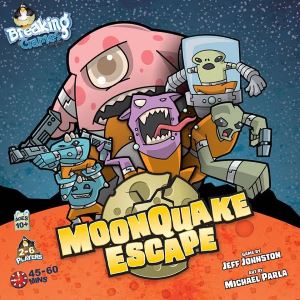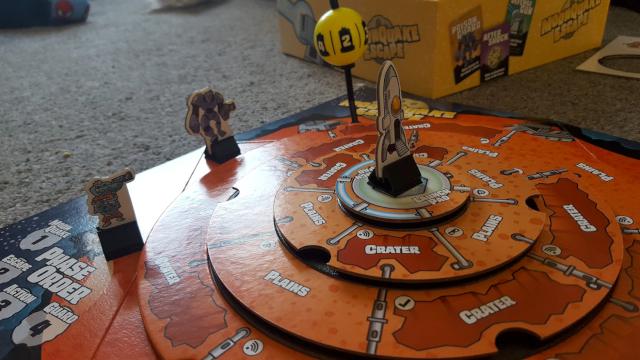
If I was on the moon I reckon I’d want to escape. There’s not much to do up there. The aliens in Moonquake Escape seem to agree, and with you at the helm they’ll be trying desperately to get to the only rocket available and get away before the other aliens beat them to it. The best way to do that? Do everything in your power to stop the others from getting there. Simple? No. Not when they’re trying to do the same to you…
The first thing you’ll notice is the board itself, which is a pretty cool multi-layered affair which allows you to rotate different layers of the moon’s surface and change the structure of the moon each time there’s a quake (as denoted by a dice roll). The various rings on the board are double sided offering two different difficulties of game, and while our first few plays of this showed the rings to be quite difficult to turn a comment from the developer on one of our recent Instagram posts suggested rubbing a little candle wax on certain parts of the rings, which did actually help the movement during the game, so that was a pretty handy interaction.
In terms of playing the game itself each player (of which 3 or 4 seems like an ideal number) picks an alien, which are identical in all but appearance, as well as a set of cards which are either placed as equipment to be used later, or in a row along with a card with your alien on. Your non-equipment cards are placed face down in front of you, and a shield is placed over one of them to help keep it safe later on – whether you cover up your alien card or something else is a decision to discuss in a moment. These cards have various effects, ranging from changing the direction that players take their turn, through to gaining an additional shot at your opponent or moving the guard character to your attacker’s location.
There’s a moon spinner, which sits elevated above the board and lets a player spin it to determine how much charge (effectively action points) players have in that round. Using a handy reference card you can then decide how to spend your charge points, taking such actions as stealing another player’s equipment cards, revealing a hidden face-down card or taking a new card from the deck. If you manage to reveal an opponents alien by flipping one over and lucking into revealing the right card that player can’t actually move towards the rocket on their turn, instead drawing more cards from the deck. In itself that could end up being quite handy, but as you’ve only got to make a small number of steps to get to the rocket, every last movement will help.

Mostly though you’ll spend at least one point of charge zapping another player, which reveals one of their cards. That is, unless they’ve added an energy shield over it. In such an instance you’ll need to zap the shield away first, then spend another charge point to zap the card underneath. But here’s where some cool bluffing comes in – has the opponent shielded their most valuable card (that is, their alien) to make it harder to reveal, or have they protected a largely useless card to trick you into wasting your points revealing a dud? It’s a risky move, your alien is one zap away from being found, but it can really make players think about just what might be underneath that shield. It’s a cool way to introduce bluffing and trickery to younger players, and a perfect chance to swear at friends when you waste your last point of charge revealing a card which does literally nothing.
Once everyone has spent the relevant actions it’s the guard’s turn to move, a game-controlled character which wanders round the moon zapping anything that’s on the same level. If you get zapped, another player acts as the guard and reveals one of your face-down cards, as they would themselves if they chose that action. You’ll either be losing some handy kit or exposing your alien and staying still on your turn. Either way you want to avoid the guard if you can.
If, when all this is played out, someone is at the launch pad with charge left to launch the rocket and an alien safely tucked away and hidden then they can hop in, fly off and leave the other aliens… no, the losing aliens on the moon where, let’s face it, it’s tough to get a decent cup of coffee. Otherwise the moon quakes again, rings move, and the sequence begins again. There are advanced rules for the reverse side of the moon rings which bring in elements like lava and radiation, each of which dramatically affect how your game pans out if you find yourself sitting in amongst it, and if you’re playing with an older group I’d certainly suggest starting on that side and leaving the simpler game all together, but if there are younger players involved that might need to simpler rules then those extras could just tip the game beyond comprehension.
But generally this game delivers for both a younger and older audience. It won’t appease the hard core gamers wanting a whole night of gaming on a single game, and might end up being one of those games you’ll dig out if you’ve only got a couple of hours spare, but you will at least dig it out and want to play it sometimes, and while the final push for the rocket can sometimes drag a bit the overall experience is very positive, and makes Moonquake Escape pretty easy to recommend for a casual group of players.

Leave a Reply